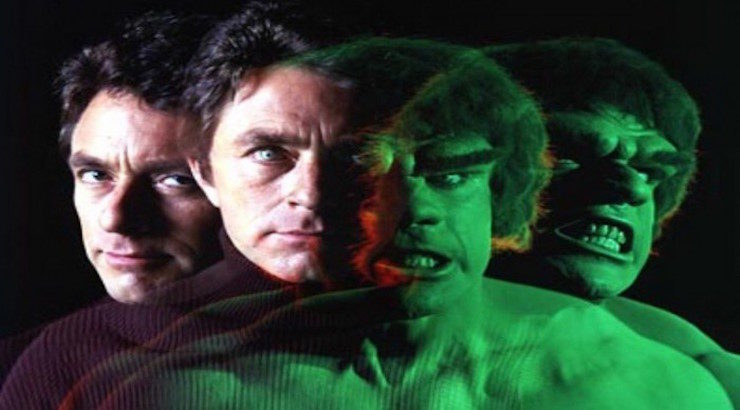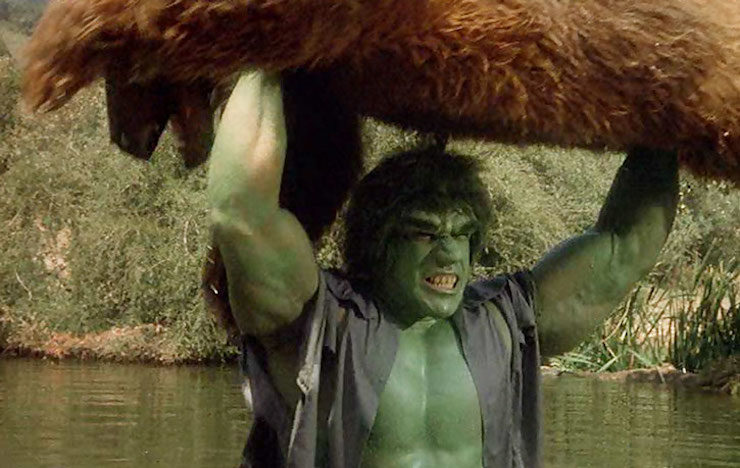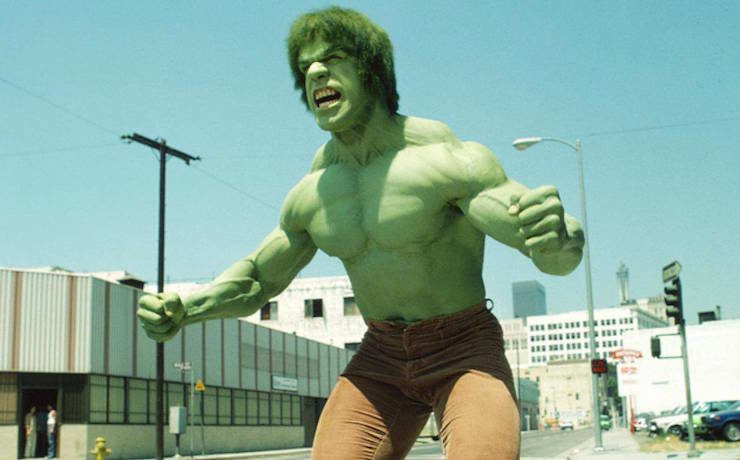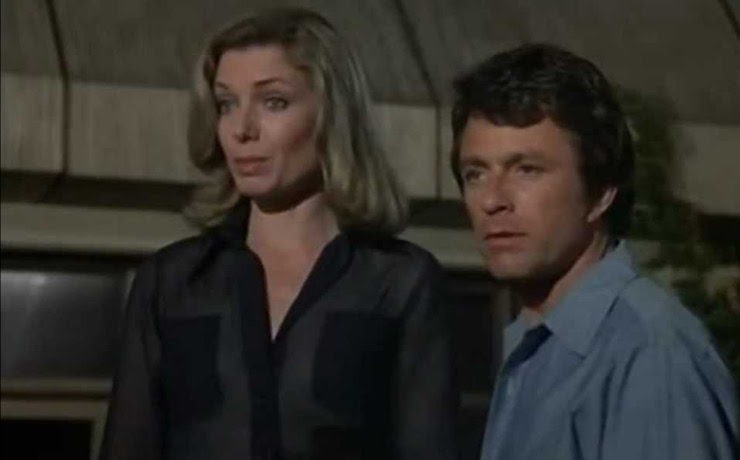In 1977, Universal Television had the rights to several different Marvel Comics characters, and Kenneth Johnson was given the opportunity to develop one of them. Johnson had come to prominence as a writer/producer on The Six Million Dollar Man, and he created the character of Jaime Somers, who was later spun off into her own series, The Bionic Woman, for which Johnson was the show-runner.
Inspired in part by Victor Hugo’s Les Misérables, Johnson decided to take on the Hulk.
Johnson made several changes due to a stated contempt for the comics medium, including changing the character’s name from Bruce Banner to David Banner. (Stories vary as to why it was changed; the most popular is that Bruce was deemed “too gay” by the network, but Johnson himself said in a 2006 interview that he wanted to move away from the Stan Lee trademark of alliterative names, e.g., Reed Richards, Peter Parker, J. Jonah Jameson, Scott Summers, etc.) Many of those changes made for better television, particularly in the late 1970s on a budget: the Hulk was less powerful than his comics counterpart, and the accident that changed Banner was a low-key lab experiment rather than a test of an atomic bomb. (That’s as much due to the passage of time as anything. The Hulk was created in 1962 before the Limited Test Ban Treaty was signed, ending above-ground bomb testing in the U.S., and 1977 was the height of the “no nukes” movement.) Johnson’s Hulk also didn’t talk, having the same grunt-and-growl vocabulary as the movie version of the Frankenstein monster. Stan Lee his own self approved that particular change, since he felt that the comics version’s “Hulk smash!” dialogue would sound silly coming out of an actual person’s mouth.
The Hulk’s supporting cast was also abandoned—no Rick Jones, no Thunderbolt Ross, no Betty Ross, no Major Talbot, no Doc Samson—with the only other recurring character being Jack McGee, a reporter who is obsessed with learning the truth about the Hulk. (There’s the Les Miz influence…)
Universal commissioned two TV movies to serve as pilots, which aired on CBS in the fall of 1977. They were sufficiently successful that it went to series in the spring of 1978. Later in syndication, these two movies would be added to the beginning of the first season as two-part episodes, with The Return of the Incredible Hulk given the title of “Death in the Family” for syndication purposes.
“It was me—and it wasn’t me…”
The Incredible Hulk
Written, directed, and produced by Kenneth Johnson
Original release date: November 4, 1977
We start with a montage of happy moments between a husband and wife: David and Laura Banner. Their connubial bliss is cut tragically short by a car accident. Banner is thrown clear of the wreck, but his wife is trapped inside, and despite the adrenaline rush brought on by the situation, he is unable to shift the car to get her out and she dies.
Banner is a physician, working at the Culver Institute with his med school buddy Dr. Elaina Marks on a project to harness the great strength that comes to people at such times as Banner’s accident. While he himself showed no signs of supernormal strength in the stressful situation, others have, and they interview bunches of them. One account is eerily similar to Banner’s own experience, except the mother was able to lift her car to save her son, where Banner was unable to do the same to save his wife. (The account triggers his PTSD something fierce…)
Meanwhile, a reporter from the National Register, Jack McGee, keeps trying and failing to get an interview with Banner or Marks. They refuse, viewing his tabloid rag as, well, a tabloid rag.
They can’t find anything common in the blood work all the way down to the cellular level, but one of their colleagues has been upgrading the equipment, and now they can examine DNA. So they do, and find a common marker in all the test subjects. They think it’s a major breakthrough, since Banner figures this is what makes him different from the others. But Marks suggests they check his DNA too, and sure enough, he has the same marker. There has to be another factor.
Gamma radiation interference prevents them from getting some information from Pittsburgh via satellite, and that triggers a notion in Banner. An investigation reveals that each of their interview subjects performed their feats of strength during a time of high gamma radiation in the atmosphere. Banner’s accident occurred during a time of very low concentrations, and he thinks this might be the key. He gets this brainstorm after hours; he calls Marks to share it, but she doesn’t answer her phone, and it’s 1977, so she doesn’t have an answering machine. So he goes ahead and irradiates himself.
At first, he notices no change—he still can’t lift the hospital bed in the radiology room—but on his way home in the rain, he gets a flat tire, and his frustrations with the process lead to him transforming into a giant, green, super-strong creature. He trashes his car, then wanders through the forest, scaring the crap out of a little girl and her father—the former fishing, the latter hunting. The father shoots the monster, but it’s only a flesh wound, and his shotgun jams before he can take a second shot.
The creature trashes the camp site after breaking the shotgun in two over his knee, but he leaves father and daughter alive. He wanders a bit, and then calms down enough to change back into Banner. He stumbles to Marks’s home, where she treats the gunshot wound—which has already healed more than is possible in so short a time frame. Marks is livid that Banner went and performed so reckless an experiment without her, but she gamely works with him to figure out what happened.
The first bombshell is that the same tinkering that enabled them to examine DNA was also done on the machine in radiology. Banner thought he absorbed 3000 units over fifteen seconds, but instead it was two million. Because of this, the attempt at an X-ray reversal, which probably would’ve worked on 3000 units, doesn’t work at all.
They decide to experiment in a supplemental lab that isn’t in use, putting Banner in a capsule designed to withstand the ocean depths. All attempts to re-create the night of the flat tire fail. After a full day of this, Marks urges Banner to rest, but sleep brings on nightmares about his wife’s death and he turns into the creature again. He trashes the capsule and the lab, Marks dutifully recording what’s happening like a good scientist. She also manages to calm him down enough to change back into Banner.
The police arrive soon thereafter, having found Banner’s car trashed and abandoned. Banner makes up a story about the car having been missing, but he didn’t report it because he thought a friend borrowed it. McGee is there too, with a plaster cast of a gigunda footprint found near his car, and also mentioning the big green hulking creature that tormented a father and daughter. Banner now knows how he got shot.
McGee breaks into the lab when Banner and Marks aren’t there, but they return while he’s snooping. When Banner catches McGee in the storage closet, he accidentally knocks over a bottle of chemicals, which then leaks. Banner removes McGee from the building, which then explodes thanks to the leaky chemicals—with Marks still inside. McGee is knocked unconscious, and Banner changes into the Hulk again, pulling Marks out. However, she has breathed in too much smoke and chemicals, and she dies in the Hulk’s arms.
Both Banner and Marks are reported killed in the explosion. McGee regained his senses in time to see the Hulk carry Marks out of the flames, and he writes a story blaming the Hulk for murdering the two doctors.
Banner, now believed by the world to be dead, wanders down the road…
“People have lost things they love because of guilt.”
The Return of the Incredible Hulk
Written and produced by Kenneth Johnson
Directed by Alan J. Levi
Original release date: November 27, 1977
Banner is hitchhiking his way to Everett, which has a state-of-the-art radiology lab. Between hitches, he sneaks onto an orange orchard and grabs a fruit. He sees a young woman on crutches visiting a grave, who collapses. After they talk for a bit, she heads back to her house, but then she collapses again. Banner carries her back to the big house where she lives. Her name is Julie Griffith. Her father, who died in a boat accident—it was his grave she was visiting—ran the orchard, and now his second wife, Margaret, runs it. Julie almost died in the same accident, but some good Samaritan saved her. However, damage to her legs from that accident means she can no longer walk without crutches.
Banner is concerned, because the drug that the nurse gives Julie isn’t the right color for what it claims to be on the label. Margaret and Julie are both grateful to him for his help, and they urge the foreman, Denny Kayle, to hire him as a picker. Kayle is very reluctant to do so, but accedes.
Julie gets a visit from her physician, Dr. John Bonifant, who gives her another injection, and sneaks in something else as well. Banner sees this, and alerts Margaret. Unfortunately, Margaret’s in on it and tells Bonifant that this picker recognized that something’s up. She has Kayle fire Banner, saying she can’t do it because she’s in fear of him. That gets Kayle’s macho up, and he and two other pickers give him severance pay and toss him out. When Banner refuses to leave without talking to Margaret first, they start to beat him up. After they toss him out the door, he turns into the Hulk, trashing the bunkhouse and the people, then buggers off.
He comes across an old drunk named Michael living in a ramshackle hut in the woods. Michael tries to befriend the Hulk, but when the Hulk tosses his bottle of whiskey into the fire, it causes a big blowup that sends the Hulk running. A little bit later, a bedraggled Banner stumbles across the hut. Michael offers him a change of clothes, and also refuses to tell the sheriff about either Banner or the Hulk when he comes by asking about a big green creature that tore up the Griffith bunkhouse.
Banner is grateful for the clothes and the silence. Michael says he doesn’t like to get involved. He also wears a medal of valor around his neck, which he says is his now. Banner doesn’t pry, but goes off to the Everett Hospital. He checks to see that Kayle is okay, then (wearing a lab coat and pretending to be a technician from the company that made the machine) inquires about the new radiation machine. He learns that it’s not in use after midnight.
After that, he breaks into Bonifant’s office, where he finds Julie’s medical records. Bonifant and Margaret arrive, and Banner hides in the closet, overhearing them talk about their plan to poison Julie—which was only enacted because Julie didn’t die in the boat explosion like she was supposed to. Bonifant also shows off his doctored X-rays of Julie’s legs that will “prove” that she has a fatal illness.
When they leave, Banner takes Julie’s X-rays, a bottle of the poison, and Bonifant’s keys, which he left on his desk. He steals Bonifant’s car and heads to the Griffith house. However, a delirious Julie doesn’t believe Banner’s story about her stepmother and doctor trying to kill her. The tenseness of the situation leads to Banner turning into the Hulk, and he picks Julie up and runs away into the swamp. Margaret orders her pet thugs to chase after them and make sure that they don’t leave the swamp alive.
Eventually, he reverts back to Banner. Julie is completely beside herself, but since she can’t walk, she has no choice but to go along with him. They go to Michael’s hut, where Julie recognizes him as the one who rescued her from the boat. Michael refuses to help her a second time, though he does give Banner another change of clothes.
Banner and Julie head toward the ranger station in the hopes of contacting the authorities. Banner stuffed the phony X-rays under Julie’s mattress before he Hulked out, and he still has the poison in his pocket. Eventually, Michael agrees to go along, and the three of them barely stay ahead of the dogs Margaret’s thugs are using to track them.
Unfortunately, they encounter a bear. Fortunately, the bear attacks Banner, which causes him to Hulk out again, and he tosses the bear across the lake. The Hulk then picks up Julie, and Michael leads them along—until he’s bitten by a rattlesnake. Julie is forced to treat the bite. While she does so, Michael explains that his son died in Vietnam—the medal of honor is the son’s—and Michael blames himself for filling his kid’s head with tales of the glory of war.
While Julie applies a tourniquet and sucks out the poison, the Hulk reverts to Banner. Michael, gimpy as he is now, offers to stay behind and misdirect the pooches while Banner and Julie continue to the ranger station. However, the Banner and Julie get stuck in quicksand, and while Julie is able to get out, Banner is not—and then in his agitation, he transforms again, which just makes it worse. Julie—whose paralysis is mostly psychosomatic, aided by the poison—manages to finally stand on her own two feet and pull down a branch that allows the Hulk to pull himself out of the quicksand. Julie manages to convince the Hulk to stay in the swamp while she awkwardly limps to the ranger station.
That does the trick, as Bonifant and Margaret and the thugs are all arrested. Michael moves into the Griffith house as Julie’s guest. She wants Banner to do likewise, but he can’t risk the Hulk hurting them. He has to keep moving. He does try to reverse the gamma radiation with the fancy new machine at the hospital (doing it after midnight with Julie and Michael standing guard), but he doesn’t have the facilities to see if it worked or not—he just has to hope that the next time he gets angry, he doesn’t transform. Julie gives him some money for the road and he hops on a bus. Meanwhile, McGee tries to interview Julie about what happened, but all she says about the Hulk is that he fell into quicksand.
“It’s like having a demon inside you.”
Normally, when a TV producer trashes most of the material from the comics source material, it doesn’t end well. Contemporary with Johnson’s adaptation of the Hulk were adaptations of Spider-Man, Dr. Strange, and Captain America that deviated from the comics to ill effect.
But for all that Johnson changed or eliminated many elements of the Hulk’s comics story, these two movies—and the TV series that grew out of it—worked. Part of it is Johnson’s own writing skill. This is the same person who wrote several of the best Six Million Dollar Man episodes, and also developed The Bionic Woman and Alien Nation, two of the better genre shows out there, and created the original V miniseries.
Part of it is also that the essence of the Hulk was kept intact. Stan Lee and Jack Kirby’s original comics were inspired partly by Strange Case of Dr. Jekyll & Mr. Hyde by Robert Louis Stevenson, and that duality of Banner’s Jekyll with the Hulk’s Hyde is very much intact here. In addition, Kirby has said that part of his inspiration for the Hulk was a story of a mother who rescued her son from a car—the very same tale told to Banner and Marks in their study in the first movie.
The best adaptations are ones that keep the spirit of the source material, and understand the basics of what makes the story what it is. Details can be changed or fixed, but as long as the story is still fundamentally what it’s supposed to be, then it can work.
Good casting helps, too, and a big reason why these movies work is the fantastic performances by Bill Bixby. His Banner is tormented, but still compassionate. He’s a good person who has had three straight tragedies—losing his wife, becoming a monster, and losing his best friend. Now he’s on the run, but he’s still, at heart, a good person, who got into medicine to help people. And while he can’t really be a doctor anymore, that need to help people is still there, which is what leads to his helping Julie in The Return of the Incredible Hulk. Bixby makes Banner into a real person about whom you care a great deal, and for whom you root.
The Incredible Hulk is a very good introduction to this version of the green giant. Like many 1960s Marvel heroes, the Hulk’s 1962 origin is very much a product of its time, tied into nuclear testing of a type that had fallen out of favor fifteen years later, so altering the origin to something more low-key than an atomic explosion was wise. It also adds a personal touch, having Banner’s frustration at not being able to save his wife.
It helps that he has Susan Sullivan to play off of. Best known lately as Richard Castle’s Mom, Sullivan is simply radiant as Marks. Her banter with Bixby is superb, as the two act exactly like best friends, and they make a good team. She’s also a smart, strong character, and a good scientist—in fact, she’s a better scientist than Banner, whose grief is causing him to make mistakes and let his emotions get in the way. Not to mention the whole irradiate himself with too much gamma thing… (I am a little confused as to why at no point the word “adrenaline” is spoken in the movie, since it’s well documented that adrenaline adds to one’s strength, but whatever.)
The followup is less impressive. It does set up the show’s format well: Banner comes into town, gets embroiled in a local situation, the Hulk shows up, and eventually the day is saved, albeit with a certain amount of Hulk-induced property damage. It’s an anthology format that also served The Fugitive and Kung Fu well, and like the former, Banner even has somebody pursuing him in McGee.
But the pacing is horrible. There’s really only an hour of story here, and it would’ve been better suited to a regular episode rather than a movie. As it is, it just drags, with the endless chase through the swamp—there’s a bear! there’s quicksand! there’s a rattler!—and then the actual capture of the bad guys happens annoyingly off-screen.
However, these movies do what they were supposed to do, which is set up a good TV show, and at least the first one also works very nicely as a story on its own.
The TV show ran from 1978 to 1982. NBC bought the rights to the show from CBS and produced three TV movies from 1988 to 1990 that were, in essence, the first attempt at a Marvel Cinematic Universe, as we got the first-ever live-action versions of Thor and Daredevil alongside the Jade Giant. We’ll look at those three movies next week.
Keith R.A. DeCandido wrote a Hulk story back in 1998 called “Playing it SAFE” for The Ultimate Hulk anthology co-edited by Stan Lee & Peter David.














